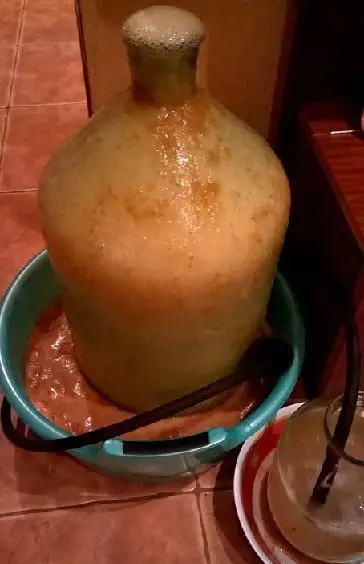Contents
The appearance of a layer of foam 3-15 cm high on homemade wine during the fermentation period is a normal situation, indicating the active work of yeast. But sometimes the foaming is too active – the foam fills the entire volume of the fermentation tank, and sometimes it comes out through the water seal. If measures are not taken in time, part of the wort will end up on the floor.
Theory
Active fermentation of wine begins 6-18 hours after the addition of yeast and lasts 7-12 days. During this period, carbon dioxide is intensively released (sometimes up to 200 bubbles from the water seal per minute) and a lot of foam appears. Active fermentation is also called “surface fermentation”, since the yeast works more in the upper layers of the wort.
You need to follow the wine foam for the first 7-10 days of fermentation with a frequency of once every 6-8 hours. If immediately after the introduction of yeast everything is fine, then this does not mean that it will continue to be so.
Gradually, fermentation slows down, and the foam layer becomes smaller. The wine enters the main fermentation phase, in which yeast fungi move to the bottom layer of the must, where they are active until all the sugar has been processed (under normal conditions).
Depending on the type of wine during quiet fermentation (maturing), the foam layer is absent or minimal (1-3 cm), gradually decreasing.
The intensity of the appearance of foam depends on three factors:
one). raw materials. From experience – plum, pear and cherry wines foam the most. Apple and grape (except Isabella grapes) are not as intense, but a lot depends on the variety, so you always need to be on the lookout. The color of the foam also depends on the raw materials: white, brown, brown, pink, red, etc. It is impossible to say by color whether everything is going well.
2). Yeast races. Cultural (store-bought) wine yeast usually produces less foam than wild yeast. The problem is that along with wild yeast or with insufficient sterility, other strains can be added to the wort, the fermentation of which causes rapid foaming. For example, the race apikulyatus living on grapes. These yeasts die at 4% alcohol concentration in the wort, but before that they manage to release a lot of foam.
3). Temperatures. The higher the temperature, the more foam the wine drives.
It is necessary to start removing the foam when it does not fit in the fermentation tank, its layer has exceeded a third of the volume in height or is actively striving for it. In all other cases, it is better to wait a couple of hours first. A foam height of 3-15 cm is considered normal.


Methods to extinguish foam on wine
If in the case of brew for moonshine a wide arsenal of chemical methods is available: cookies, vegetable oil, kefir, milk, special defoamers and even baby shampoo, then with wine the situation is different, since we cannot add other substances so as not to spoil the taste. You have to rely solely on physical methods to solve the problem.
Do not stir the wort, otherwise it will begin to foam even more actively!
1. Separate the wort
The optimal method. It helps if initially there was little space in the tank (at least a third of the volume should always remain free) or a foam layer no larger than the must layer (one to one or less).
Wine should be poured into several containers, installing a water seal on each. Transfusion is best done on the street or in non-residential premises, since with an abundance of foam it is difficult to complete the procedure without spilling at least a little wine on the floor. In addition, the characteristic smell of fermentation will appear in the air.
2. Remove foam
Simply remove with a slotted spoon or any other tool. The disadvantage of the method is that the foam contains the most active yeast, which brings carbon dioxide to the surface. Then the gas bubble bursts, and the “hungry” yeast cell descends back into the wort, where it eats sugar, producing new carbon dioxide, which again lifts it up. If you remove the foam with a slotted spoon, then not all, otherwise the fermentation will slow down greatly.
3. Lower the temperature
The optimum fermentation temperature is 18-24°C; when it rises to 30°C, wine yeast may die, and at 16°C and below, their activity slows down or stops altogether.
It is enough to lower the temperature of the wort to 16-20°C. This will reduce the foam, but will not stop the fermentation completely. The disadvantage of the method is that it is not always possible to adjust the temperature by a couple of degrees, moreover, the fermentation period will increase.
4. Restart fermentation
A radical measure that is used when infecting the wort with third-party yeast races. Signs of infection: there is a lot of foam, it exceeds the volume of juice several times, an unpleasant smell is felt, which is not present during normal fermentation, the wort can become viscous, strange notes appear in the taste. It is not possible to describe the taste and smell in more detail, since these organoleptic properties depend on the yeast strain, and there are a lot of them. The main landmark is a very large amount of foam (as in the photo).

In this case, pasteurization of wine will help. It is necessary to drain the wort from the sediment, heat to 65-70°C (preferably without air), boil for 3-5 minutes at the specified temperature, then install a water seal on the container and cool to 20-24°C. At the final stage, add sourdough or wine yeast to restart fermentation.










کف با ماندگاری بالا یعنی اتانول.کف با ماندگاری پایین یعنی متانول چون سمی هست کف ها را زود میترکاند